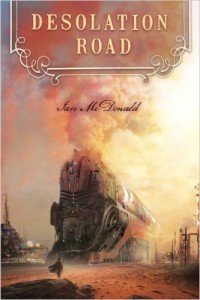 Chuck Lipsig penned this review.
Chuck Lipsig penned this review.
I figure this much: Ian McDonald’s Desolation Road starts with a green man crossing the desert, so this has to be the perfect book for Green Man Review. OK, the book calls him a “greenperson,” and the desert is on a Mars of the future, transformed by mankind’s effort, but you get the idea. Trailing this greenperson is Dr. Alimantando. He comes to a place along a railroad, where, almost accidentally, he settles and starts the community that he names Desolation Road. Soon after, more people begin arriving and, in short order, the community becomes a village, a city, a war zone and a ghost-town — all within 23 Martian years. That’s the story.
But the story is far more than that. The future will have its myths, legends, and fairy tales. Desolation Road, more than a straightforward novel, is a cycle of these tales with odd visitors coming to Desolation Road — some of them staying — and its children leaving for their own adventures throughout Mars. Along the way, the reader meets, among many others, cybernetic saints; a four-handed guitar player who has killed in a musical duel; and a master of deadly sarcasm. Besides Desolation Road, the story takes the reader across a futuristic, fantastical Mars, from the wicked city of Belladonna, where nearly any vice can be found, and Glen Miller owns a jazz bar, to the toxic, sulphurous lakes of Kershaw.
McDonald endows the Martian world with people and places, at once futuristic and archetypal. Sacred groves and forests are recalled by “the Forest of Chryse, the Ladywood, oldest of all the world’s young places, where St. Catherine herself planted the Tree of World’s Beginning with her steel manipulator.” The list of snooker opponents who fall to Limaal Mandella reads like a list of knights taken on and defeated by a great champion. The feel of Desolation Road comes close to matching Cordwainer Smith in creating new, but quite human, spiritualities in fantastical, futuristic settings — quite an accomplishment, in my judgment.
There is one problem with Desolation Road: There are so many characters that few get portrayed with the depth they deserve. For example, Rajandra Das, the hobo with an empathy with machines, has a nice scene at the start, is there almost to the end, but does very little in between — and most of that has nothing to do with his talent. Eva Mandella spends the novel weaving a tapestry of the history of Desolation Road, but is little more than a shadow in the background of the story. Even the characters who get more meat to their personalities — for example, the mystical, saintly Taasmin Mandella and her rational, champion snooker-player brother, Limaal — get far less attention than they deserve.
But this sort of annoyance is common to many a fine novel. Desolation Road has a feeling of a chronicle — a holy scripture, almost — and such narratives are rather given to such gaps. Furthermore, it is fair to say that the main character of this story is not any of the individuals in it, but rather the eponymous community. The result is a novel that is highly satisfying, but oddly unfulfilling. I liked it a lot — but I still want more.
(Bantam Books, 1988)
